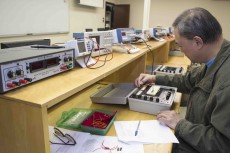By Matthew McConathy/reporter
Most experts cite 1994 as the year the Internet gained widespread use.

Bogdan Sierra Miranda/The Collegian
In the more than two decades since, technology has changed how professors teach and students learn.
Without a smartphone or a laptop, a person cannot use email or social media, making it harder to do daily tasks.
“Technology has slowly evolved to what it is today,” said NE management coordinator Mary Alice Smith.
Today, students use PowerPoint, Word and other software as learning tools to help in their studies.
“I can access certain classroom assignments online through email and the school website resources,” NE student Kyle Bumgardner said.
In 1994, computers were less user-friendly, making them a hassle to use.
“In the late 1980s, we used word processing machines that were very expensive equipment,” Smith said. “Students did not use the Internet as a daily task. It was first-person communication. Not everyone liked using a computer back then. Students were afraid they would break the computer by not knowing how to use it.”
Competence with computers was more task-oriented than a source of enjoyment in the early 1990s.
“Students have become more keenly aware how to use computers because they grew up in the technology generation,” computer science assistant professor Betty Dalton said. “Students at TCC did not have computers in their classroom in 1994. They used computer labs.”
Technology has made it easier to communicate between students and faculty, yet it can hinder face-to-face communication skills.
“Social media impacts students that can’t spell or use good grammar,” Dalton said. “Students have less personal communication because of social media and lose their body language through Facebook, Instagram and digital media.”
But she said software is much better now.
“We used to use WordPerfect to write papers,” she said. “Lotus 123 was used as a spreadsheet, along with MS-DOS and Windows 3.0. They were less user-friendly.”
All of those have been replaced, and now replacements are coming more quickly.
“We’ve come a long way from what it would take 10-15 years in the past generation to enhance technology to two to three years in today’s generation,” said media services district director David Mead.
With the integration of technology and distance learning, TCC has seen more success in learning without being in a classroom.
“I want to change people’s minds on technology and what it can do for them,” Mead said.
Before online registration, TCC used arena registration.
“Students would wait to come up to department booths, and they could get personal advice about their classes they wanted to take and register for them,” Dalton said. “Today it’s online, and you have to do the researching yourself for your class requirements.”
Technology has changed information systems, databases and search engines, but it can be relied on too much.
“The problem with technology is that students think the computer will do the work for them,” Smith said.
Yet in many ways, technology has improved tedious tasks that used to take much longer.
“I enjoy technology today to communicate quickly and access information,” Dalton said.
The TCC library is the main source of research, and the coming of electronic database search engines has made it easier to find topics based on keywords.
“I enjoy having computers available in the library for online research,” said NE student Katy Dangal.
Online learning sites such as Stanford Online and Khan Academy are built to teach students free online learning, offering students a gateway for enhancing education for their careers through online databases.
“The learning tools that are interactive can be able to receive instruction, simulated application, interaction and databases in libraries,” Smith said.
Technology has increased accessibility and faster resources to students and faculty.
“Technology is very important as I have to work with it on a daily basis, get to learn to build a computer and know more about them,” Dangal said.
Smith believes classroom technology will continue to expand,
“I believe that the future of technology on campus will be with online resources and more interactive learning through technology, cutting down on textbooks,” she said.
Mead sees a more non-traditional future.
“Holograms, 3-D printers and audio textbooks are currently coming to this generation,” he said.






























